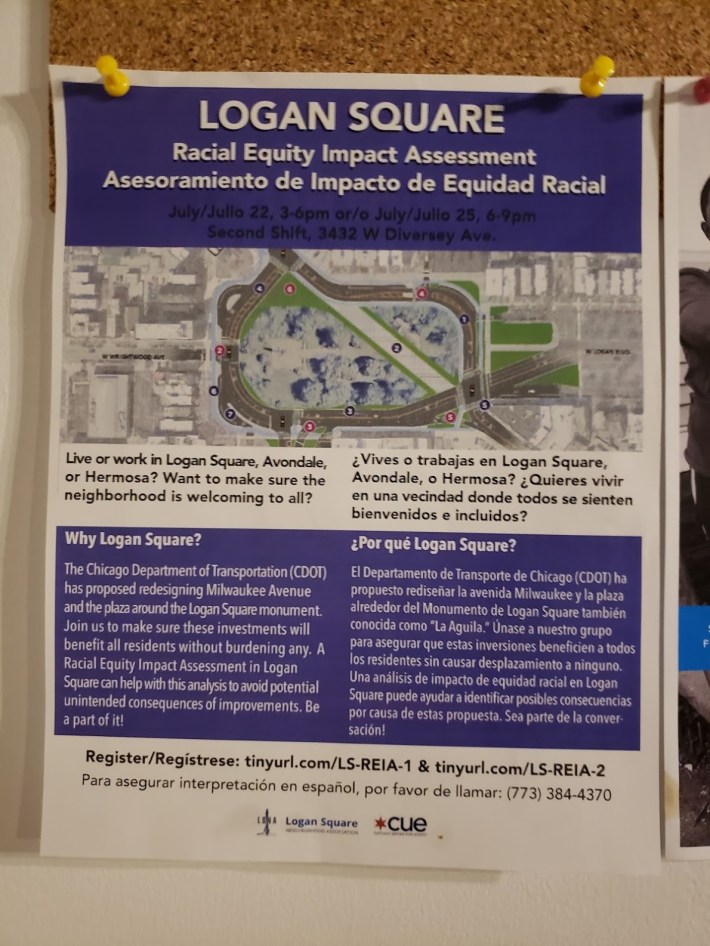As part of the Chicago Department of Transportation's ongoing project to improve safety on Milwaukee Avenue, Logan Square's namesake "square" (really, a traffic circle), which is currently dangerous and inconvenient for pedestrians and cyclists, is slated for a redesign. CDOT has laid out four proposals, and residents have been able to weigh in online and at various public meetings over the past year. The department will select a final design in the coming year, with construction scheduled for in 2020.
As any Northwest Sider with a pulse can tell you, Logan Square has seen some major changes in the past decades. From 2000 to 2014, roughly 19,200 Latinx residents left the neighborhood -- a 35.6 percent drop, according to a DNAinfo report. Many of them were lower-income and working-class people forced out as property values, taxes, and housing costs rose in conjunction with an influx of white and more affluent newcomers, plus upscale retail and development.
In an effort to stop the displacement of longtime residents, the Logan Square Neighborhood Association -- a longstanding nonprofit champions of affordable housing and racial and economic justice -- is partnering with the Chicago United for Equity group to conduct a Racial Equity Impact Assessment on the proposed circle redesign project.
A REIA is a tool that may be applied to plans or policies to assess whether they will ultimately benefit the many or just the few, especially when it comes to race. LSNA and CUE began the process in January and have conducted two public REIA trainings thus far, the second of which was last Wednesday, July 25, at Second Shift in Logan Square.

LSNA youth representative Ashley Galvan Ramos kicked off the session by telling the story of her own family's displacement from Logan Square. Christian Diaz, lead housing organizer for LSNA, explained that when longtime residents have to leave the neighborhood, it's not just a matter of losing their housing. People also lose community support networks built over decades, as well as convenient transportation access to jobs and other resources. These losses can be especially hard for already-marginalized folks such as single parents. "The impacts of destabilized housing can be felt for generations," Diaz said.
The Racial Equity Impact Assessment process is a strategy to get residents and others to prioritize racial justice in the planning process, as well as to get those who would be most impacted by neighborhood changes involved in decision-making from the very beginning.
The main questions an REIA attempts to answer are:
- Who benefits from a plan or policy?
- Who is burdened and how?
- How can we increase the benefits, and decrease the burdens?
Juan Sebastian Arias, a CUE fellow, moved to Logan Square from Ecuador with his family in the 1980s. Arias discussed the possible outcomes of CDOT's four proposed design alternatives for the traffic circle. Some residents are in favor of the boldest options: building a plaza at Kedzie and Milwaukee by Logan Square Blue Line station and routing Milwaukee Avenue traffic around the square instead of through it. Arias noted that it's important to consider how these changes might affect mom-and-pop businesses.
After the CUE fellows introduced the process, they led participants in smaller breakout groups to complete REIA worksheets together. Each group brainstormed not only potential impacts, but also asked how intended outcomes could help advance racial equity.
In the groups I observed, I heard some concerns that making the area more accessible and appealing for walking, biking, and spending time would raise property values and rents, which could drive out lower-income residents and small businesses. However, the argument made that improving access and safety for non-car transportation can also help people save money.
Participants were interested in accessing data about similar street designs to see if it backed up their suppositions. But they also stressed the value of using firsthand stories in the planning process to highlight the human toll of displacement.
Jenny Nagoaka, an education researcher who has lived in Logan Square for the past decade, attended the training both out of professional interest and as a neighbor. “Like all of us here, I've seen the changes," she said. "Even though I've kind of been part of them, I am interested in helping keep the neighborhood as diverse and accessible as possible.”
New resident Sean Killarney said at first he had assumed that adding green space to the neighborhood would be beneficial for everyone who lives there. “But this process helped me better consider whether [the new public space] was truly needed, and who it would actually benefit in the long run, especially if rents go up," he said.
Chicago United for Equity and Logan Square Neighborhood Association will host another equity assessment workshop in the fall, and will share their findings with CDOT in time for the department's next public meeting. In the meantime, people can submit comments about the project to CDOT here.





